Pretty sure Dunlavy used first order, time aligned. Always thought this was one of the smartest commercial designs.
They used to be commonly used for mastering monitors (different than mix monitors).
I vaguely recall Dunlavy hung out on forums (maybe the basslist?) occasionally back in the day.
It was the basslist, I have saved a compilation of all his posts, picked it up somewhere as someone took the time to get them all together. Great engineer, not as good in marketing.
"Generically, the rather complex crossover falls into the minimum-phase, first-order (6dB/octave) category, but Dunlavy says it cannot be accurately described in terms of conventional slopes and crossover points. There's also a network to notch out the tweeter's resonant frequency and conjugate load matching to produce an easy impedance load."
Here's a good pointer.. though we can do digital time alignment using miniDSP we'd still have to do impedance compensation as we cannot (seem to) do that with these tools. It still won't make it easy to find drivers that are up to the task. Dunlavy used 5 drivers and later on 7 to achieve it. I use 25 to come close.
Last edited:
I am back to LR4 at 400Hz and listening. It can handle more power, sounds cleaner, less distortion. But, the cue ball shot on Last Payday doesn't sound as convincing. Just that mainly. To a certain extent the phantom imaging on the BW1 at 350Hz is better. More full range-like.
Why not LR2? I prefer LR2 to LR4 and only use the steeper slopes if I have to for one reason or another. At the point that you're crossing, LR2 should not be a problem. The 10f will likely have a bit more intermodulation distortion, but at the levels you say you listen at it shouldn't really be a problem
With textbook filter (such as DSP without programming feature) you will rely on the natural roll-off of the drivers. Here, RS225 is not suitable, not only because it has "wiggles" at roll-off response, but aluminum cone has harsh breakup sound (which you can not see from casual measurement).
RS225 is more suitable with complex and steep crossover. But they have more problems to solve. The problem that does not exist in full range approach is of course the phase related issue. This is confusing as we have too many phase-related "variables", and most people just cannot hear anything so they just "guess"...
I agree that you can't just use a textbook filter. That's why you need to measure and preferably use a simulation to figure out how to hit the textbook targets. You can cross lower/higher than target and use peq if needed to get there.
And remember that he's crossing at 350Hz so he probably doesn't quite need super steep slopes on the RS225
The RLC network to flatten the impedance peak is technically called "conjugate load matching"? Makes send now - and I look forward to the 25 driver TC9 tower have this.
Sort of, don't think I've heard the term load matching, but yes it can be called a conjugate. The thing is that I don't know if it necessary with a digital xo because the xo is not dependent on impedance the way a passive is. Maybe it does something with the amps that doesn't allow it to be time coherent, I don't know. If you wanted to try it on a active speaker, I guess you would need two RLC networks, one across each speaker. Or maybe just a zobel across each driver.
Anyways, I can see a use for it in dealing with a driver's resonant peak if you're crossing too close to it- like you are with the 10F. An aperiodic mid enclosure can do the same thing though.
LR2 up next... I guess I am getting back to subjective impressions of how these different slopes and phase wraps may sound.
Did you ever try the simulation? Even if it works better than the one you did yesterday, there's still no protection on the 10f besides the enclosure and I notice the verticle lobbing could be better above the xo. But it could be worth at least trying.
BTW, you mentioned going to passive on this once you figure it out. I spent 5 minutes putting a passive sim together last night with BW1 and I don't know if that's really something you want to try....many, many large parts!
I am back to LR4 at 400Hz and listening. It can handle more power, sounds cleaner, less distortion. But, the cue ball shot on Last Payday doesn't sound as convincing. Just that mainly. To a certain extent the phantom imaging on the BW1 at 350Hz is better. More full range-like.
How are you implementing this? Did you just slap on an LR4 filter at 400Hz? Because as Jay said, this doesn't work, especially with the RS225; it needs more work than that to hit your target
Did you ever try the simulation? Even if it works better than the one you did yesterday, there's still no protection on the 10f besides the enclosure and I notice the verticle lobbing could be better above the xo. But it could be worth at least trying.
Yes, I was up until 3a last night messing with it. Too tired to take data and post though but will summarize in words...
I set the 3-PEQ's exactly like you said, found I had a typo on one which you picked up on - I think it was the 950Hz, supposed to be Q=0.5 but I had 1.5 - duh... I set the delay on the RS225 at -0.16ms and zero on the 10F. I did it with the 2 small PEQ's on the 10F and without, and ran the 10F full range flapping in the wind whenever a kick drum hits. I tried -4dB cut on level of 10F but found that was not enough to balance.
It sounded pretty good but there was a wide and shallow (-5 to -6dB) cancellation trough at the XO region. Looking at the SR though, it was the widest right triangle ever that crossed zero at 4ms. However, the triangle had a few notches missing on the slope corresponding to the cancellation trough at the XO.
So I then tried putting the delay on the 10F at -0.16ms and got the cancellation trough to go away, but the step response triangle was not as wide anymore. So there is something going on at the XO region that is not matching our expectations or models. I need to make sure the voice coil polarity is not flipped somehow (either in the driver or my internal cabinet wiring). But if that was bad, all my other stuff would have been bad too.
It's a little frustrating to not be able to trace the source of this weird phase anomaly. With your -0.16ms delay on the woofer setup, the percussive dynamics and impulse sound quality are very good - the mid bass at XO just feels depressed as it is. I don't like the very large amounts of distortion that the 10F squeezes out below 350hz though as it is running full range and the HD plots bear that out. It cannot go unfiltered, -6dB/oct minimum to keep it clean.
By contrast, I loaded up the DSP settings for my earlier LR4 at 400Hz, and the sound quality increased dramatically in terms of lower distortion and less mudiness. However, the spatial imaging was not as good, and the click of the cue ball hitting the rack in Last Payday was not as realistic.
I listened to a duet viol track #11 from Tous Les Matins du Monde soundtrack - great test of a 350Hz XO as the chords go up and down past this region. Again, it sounded cleaner at LR4 400Hz but the imaging was not as realistic. In the BW1 and no XO mode, I could place the two viols in a small chamber and hear the bow rapping on the viol body occasionally, and even occasionally hear the breath of the musician, imaged perfectly.
So later tonight I will test LR2 again. I wish I wasn't so busy with other stuff that by the time I have to play I am basically dead tired and about to doze off.
I wish I wasn't so busy with other stuff that by the time I have to play I am basically dead tired and about to doze off.
X, get some rest man.
Maybe a good time to zone out and listen to some music...
Rested and refreshed, continue on your journey.
Glad you're trying all these various xover slopes out. So far, you're impressions are pretty similar to mine. LR4 is solid reliable and sounds good, but 1st sounds the most real. Main disadvantage IME is lobing can be pretty severe, but in a FAST probably not a huge issue.
If a steeper crossover is required, I often like 3rd Bessel. Put that on your bucket list. IIRC this mangles a square wave less than other steep crossovers. Requires a bit of offset for the phase to line up, but that can work to your advantage with a FAST.
IIRC this mangles a square wave less than other steep crossovers. Requires a bit of offset for the phase to line up, but that can work to your advantage with a FAST.
Dunlavy was going against the grain at the time. IIRC he took a lot of heat for his crossover choice.
If a steeper crossover is required, I often like 3rd Bessel. Put that on your bucket list.
Dunlavy was going against the grain at the time. IIRC he took a lot of heat for his crossover choice.
Dunlavy was going against the grain at the time. IIRC he took a lot of heat for his crossover choice.
I've seen a lot of people disagreeing with him on driver choice as well.
"It just can't sound right with those cheap Vifa drivers"

He also had a fair price, nothing like the bloated prices others were asking.
Which Vifa drivers was Dunlavy using?
I have noticed the presence of the letter "v" in esteemed speaker brands.
Dunlavy, Von Schweichert, Vandersteen - there are probably more...
Is this a trend here? It's like all matresses in the US start with the letter "S" for subliminal message in the illiteration of the first letter for sleep.
Simmons, Serta, Sealy, etc.
I have noticed the presence of the letter "v" in esteemed speaker brands.
Dunlavy, Von Schweichert, Vandersteen - there are probably more...
Is this a trend here? It's like all matresses in the US start with the letter "S" for subliminal message in the illiteration of the first letter for sleep.
Simmons, Serta, Sealy, etc.
Main disadvantage IME is lobing can be pretty severe, but in a FAST probably not a huge issue
Do you mean the lobing caused by the comb interference of the high frequencies that leak out past the woofer to cancel with the full range or tweeter? I have not seen that to be a problem in the measurements yet. The distance between the woofer and tweeter is 8in in my case. Maybe some should be appearing above 500Hz.
Yes, I was up until 3a last night messing with it. Too tired to take data and post though but will summarize in words...
I set the 3-PEQ's exactly like you said, found I had a typo on one which you picked up on - I think it was the 950Hz, supposed to be Q=0.5 but I had 1.5 - duh... I set the delay on the RS225 at -0.16ms and zero on the 10F. I did it with the 2 small PEQ's on the 10F and without, and ran the 10F full range flapping in the wind whenever a kick drum hits. I tried -4dB cut on level of 10F but found that was not enough to balance.
It sounded pretty good but there was a wide and shallow (-5 to -6dB) cancellation trough at the XO region. Looking at the SR though, it was the widest right triangle ever that crossed zero at 4ms. However, the triangle had a few notches missing on the slope corresponding to the cancellation trough at the XO.
So I then tried putting the delay on the 10F at -0.16ms and got the cancellation trough to go away, but the step response triangle was not as wide anymore. So there is something going on at the XO region that is not matching our expectations or models. I need to make sure the voice coil polarity is not flipped somehow (either in the driver or my internal cabinet wiring). But if that was bad, all my other stuff would have been bad too.
It's a little frustrating to not be able to trace the source of this weird phase anomaly. With your -0.16ms delay on the woofer setup, the percussive dynamics and impulse sound quality are very good - the mid bass at XO just feels depressed as it is. I don't like the very large amounts of distortion that the 10F squeezes out below 350hz though as it is running full range and the HD plots bear that out. It cannot go unfiltered, -6dB/oct minimum to keep it clean.
By contrast, I loaded up the DSP settings for my earlier LR4 at 400Hz, and the sound quality increased dramatically in terms of lower distortion and less mudiness. However, the spatial imaging was not as good, and the click of the cue ball hitting the rack in Last Payday was not as realistic.
I listened to a duet viol track #11 from Tous Les Matins du Monde soundtrack - great test of a 350Hz XO as the chords go up and down past this region. Again, it sounded cleaner at LR4 400Hz but the imaging was not as realistic. In the BW1 and no XO mode, I could place the two viols in a small chamber and hear the bow rapping on the viol body occasionally, and even occasionally hear the breath of the musician, imaged perfectly.
So later tonight I will test LR2 again. I wish I wasn't so busy with other stuff that by the time I have to play I am basically dead tired and about to doze off.
Sounds like you had polarity reversed. This will cause your dip and because of the BW1 xo the dip is only 5-10db.
The lack of mid bass is most likely due to the level being to high around the xo, ie. not enough baffle step. Try bringing the RS225 xo down to around 150-175Hz
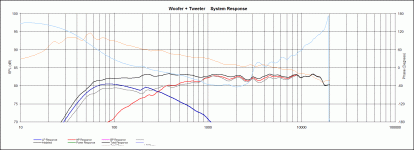
This is with the RS225 xo set at 150Hz (ignore the response below 200 as this is an aproximation of your enclosure with no LT). Positive polarity on both drivers. Gray line is with the drivers flipped. The phase looks like sh!t to me, but I don't know much about BW1 crossovers.
As far as I can see there's no way around the lack of a xo on the 10f except for higher xo points, higher slopes or ported/apeirodic enclosure. And I don't doubt that it needs a crossover
Do you mean the lobing caused by the comb interference of the high frequencies that leak out past the woofer to cancel with the full range or tweeter? I have not seen that to be a problem in the measurements yet. The distance between the woofer and tweeter is 8in in my case. Maybe some should be appearing above 500Hz.
you'll need to measure above and below axis to see this.
I'm not really seeing this any more in PCD. I was with some earlier sims. The problem now is that the sum above the xo raises as you go below axis, usually this is never a good thing, but it's not bad until 15 degrees out, so you'd have to listen on the floor to maybe hear it.
BTW, you mentioned going to passive on this once you figure it out. I spent 5 minutes putting a passive sim together last night with BW1 and I don't know if that's really something you want to try....many, many large parts!
Yes, I would be interested in seeing your design. The one Byrtt came up for me had a big 57uF cap and a 2.65mH coil. Both were manageable - you have bigger components than that? The whole reason for the BW1 xo is for the phase linear transient perfect response, and to do that requires time alignment. The only way to do this without an all pass delay that add cost and phase wrap is to separate the tweeter and woofer into 2 cabinets and move tweeter backwards to get time alignment. Notice that the Dunlavy has each driver successively stepped farther and farther back. A solution to this would be the synergy horn where time delays can be added by moving locations of injection ports.
Last edited:
So later tonight I will test LR2 again. I wish I wasn't so busy with other stuff that by the time I have to play I am basically dead tired and about to doze off.
Here's what you can start with instead of guessing and measuring; should leave more time to listen before you fall asleep
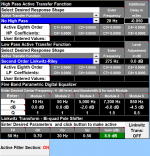
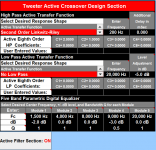
Mid is wired with reversed polarity
This is what it looks like-
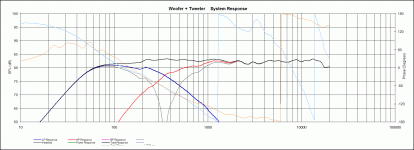
And zoomed out so you can see the notch-
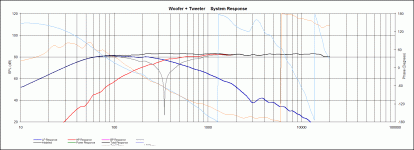
If it doesn't have enough bass then lower the woofer xo and reduce the mid's level. this is the equivilant of increasing the coil and adjusting the lpad on a passive xo to deal with baffle step. If you want to try this and you want it to look like this, you have to observe all stettings, xo points, peq q and level, delay the correct driver the correct amount and set polarity right. Or not....
If you download Jeff Bagby's PCD then I'll just give you this file and you can play on your own. you really need to be able to sim active xo's anyways if you're going to keep doing this
Are you using the WinPCD (.NET) or the original Jeff Bagby excel spreadsheet (passxodesigner5.1.exe)?
David Ralph's Speaker Pages - WinPCD Release Information
Passive Crossover Designer
Anyhow, please get me the file - either post here or PM me. Thanks.
- Home
- Loudspeakers
- Full Range
- 10F/8424 & RS225-8 FAST / WAW Ref Monitor